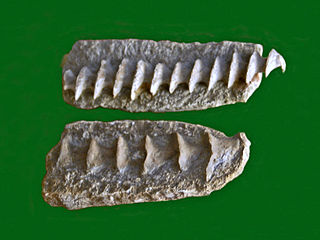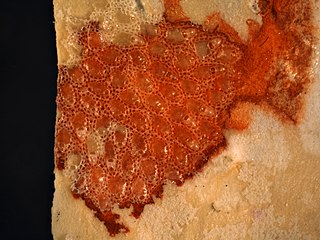
Bryozoa are a phylum of simple, aquatic invertebrate animals, nearly all living in sedentary colonies. Typically about 0.5 millimetres long, they have a special feeding structure called a lophophore, a "crown" of tentacles used for filter feeding. Most marine bryozoans live in tropical waters, but a few are found in oceanic trenches and polar waters. The bryozoans are classified as the marine bryozoans (Stenolaemata), freshwater bryozoans (Phylactolaemata), and mostly-marine bryozoans (Gymnolaemata), a few members of which prefer brackish water. 5,869 living species are known. At least, two genera are solitary ; all the rest are colonial.
Stenolaemata are a class of exclusively marine bryozoans. Stenolaemates originated and diversified in the Ordovician, and more than 600 species are still alive today. All extant (living) species are in the order Cyclostomatida, the third-largest order of living bryozoans.

Cheilostomatida, also called Cheilostomata, is an order of Bryozoa in the class Gymnolaemata.

Archimedes is a genus of bryozoans belonging to the family Fenestellidae. The first use of the term "Archimedes" in relation to this genus was in 1838.

Paleontology in Oklahoma refers to paleontological research occurring within or conducted by people from the U.S. state of Oklahoma. Oklahoma has a rich fossil record spanning all three eras of the Phanerozoic Eon. Oklahoma is the best source of Pennsylvanian fossils in the United States due to having an exceptionally complete geologic record of the epoch. From the Cambrian to the Devonian, all of Oklahoma was covered by a sea that would come to be home to creatures like brachiopods, bryozoans, graptolites and trilobites. During the Carboniferous, an expanse of coastal deltaic swamps formed in areas of the state where early tetrapods would leave behind footprints that would later fossilize. The sea withdrew altogether during the Permian period. Oklahoma was home a variety of insects as well as early amphibians and reptiles. Oklahoma stayed dry for most of the Mesozoic. During the Late Triassic, carnivorous dinosaurs left behind footprints that would later fossilize. During the Cretaceous, however, the state was mostly covered by the Western Interior Seaway, which was home to huge ammonites and other marine invertebrates. During the Cenozoic, Oklahoma became home to creatures like bison, camels, creodonts, and horses. During the Ice Age, the state was home to mammoths and mastodons. Local Native Americans are known to have used fossils for medicinal purposes. The Jurassic dinosaur Saurophaganax maximus is the Oklahoma state fossil.

Cystoporata, also known as Cystoporida or cystoporates, are an extinct order of Paleozoic bryozoans in the class Stenolaemata. Their fossils are found from Ordovician to Triassic strata.

Chorizopora brongniartii is a species of bryozoan in the family Chorizoporidae. It is an encrusting bryozoan, the colonies forming spreading patches. It has a widespread distribution in tropical and temperate seas.
Septopora is an extinct genus of bryozoan belonging to the order Fenestrida. It has been found in Pennsylvanian to Permian beds in North America, South America, Australia, and southwest and east Asia.
Tabulipora is an extinct genus of bryozoan belonging to the order Trepostomida. It has been found in beds of Permian age in North America, Spitzbergen, South America, and Asia. Specimens typically form cylindrical branching colonies.
Utgaardostylus is an extinct Permian bryozoan genus of the family Dyscritellidae. It was discovered in northeastern Nevada.
Wyseotrypa is an extinct Permian genus of bryozoans of the family Hyphasmoporidae. It was discovered in northeastern Nevada.
Monticulipora is an extinct genus of Ordovician bryozoans belonging to the family Monticuliporidae. It was first named in 1849, and its description was published the following year by French paleontologist Alcide M. d'Orbigny, making it one of the earliest bryozoans to be recognized in science. It is still one of the most widespread fossil bryozoan genera. Though colonies that grow in masses made of multiple layers are characteristic of the genus, its colonies have varying shapes, able to be encrusting, branching, massive, or frond-like, and are covered in monticules (bumps). Most Monticulipora species have distinctively granular walls, and Monticulipora and can be distinguished from Homotrypa by the presence of axial diaphragms.
Dekayia is an extinct genus of Ordovician bryozoans of the family Heterotrypidae. Its colonies can be branching, encrusting, or massive. All species have acanthopores in varying sizes and numbers. The autozooecia appear angular or sub-angular viewed through a cross-section of the colony, and their walls are distinctively undulating or crenulated. Maculae generally protrude from the colony surface very little or at all, and can contain unusually large autozooecia and a cluster of mesozooecia in their centers.
Homotrypa is an extinct genus of bryozoans from the Ordovician and Silurian periods, known from fossils found in the United States. Its colonies are branch-like and have small monticules made of groups of three or four larger zooecia slightly protruding out from the main surface of the colony. In cross section, the zooecia are erect in axis and gently curve toward the surface of the colony.
Eridotrypa is an extinct genus of bryozoans of the family Aisenvergiidae, consistently forming colonies made of thin branches. Diaphragms are very common in colonies. Distinctively, in the exozone there are serrated dark borders separating the autozooecia.
Stenopora is an extinct genus of bryozoans first described in 1845, using material collected by Charles Darwin. Its colonies can be branching, frondescent, encrusting, or massive, and shapes display variation even within single colonies. Diaphragms are absent and acanthostyles of uniform size surround its zooecial apertures.
Prasopora is an extinct genus of bryozoan belonging to the family Monticuliporidae, known from the Middle Ordovician. Its colonies were disc-shaped or hemispherical, flat on bottom and convex on top, and had very abundant mesopores; in the case of the species P. insularis its zooecia were isolated from each other by the numerous mesopores surrounding them. It is very similar to the genus Monticulipora, and some bryozoan species have been assigned to both genera at different points in their study, but it is mostly distinguished by having more mesozooecia, rounder autozooecial apertures, relatively few acanthostyles and diaphragms and cystiphragms equally distributed in the autozooecia.
Fistuliphragma is an extinct genus of cystoporate bryozoan of the family Fistuliporidae that lived in the Devonian period. Its colonies could have branched or encrusting forms, with hollow tubular branches in the case of the branched form, and possessed a well-developed vesicular skeleton. Its autozooecia possessed prominent lunaria and hemiphragms. The genus is distinct from Cliotrypa and Strotopora because of the absence of gonozooecia.
Stenodiscus is an extinct genus of bryozoan of the family Stenoporidae, known from the Carboniferous to the Upper Permian periods. Its colonies were large and could be encrusting, massive, or branching, sometimes made of multiple layers of growth over themselves, and usually possessed monticules with abundant large acanthostyles.
Tarphophragma is an extinct genus of Middle and Upper Ordovician bryozoans of the family Halloporidae. Its colonies began from an encrusting base and grew into branching structures. Raised maculae made from mesozooecia and large autozooecia covered the colony's surface, and its autozooecia were arranged in a disorderly pattern. Its interzooidal budding pattern and integrate wall structure distinguish it from other genera.





